Abstract
Intracellular activation of pancreatic digestive enzymes by lysosomal hydrolases is thought to be an early event in the pathogenesis of pancreatic injury. As ethanol excess is an important association of pancreatitis, experimental work has been directed towards exploring possible mechanisms whereby ethanol may facilitate contact between inactive digestive enzyme precursors and lysosomal enzymes. The aim of this study was to find out if chronic ethanol administration increases the fragility of rat pancreatic zymogen granules. Sixteen male Sprague-Dawley rats were pair fed ethanol and control liquid diets for four weeks. Zymogen granule fragility was then assessed in pancreatic homogenate by determination of (a) latency and (b) per cent supernatant enzyme after sedimentation of zymogen granules. Amylase was used as a zymogen granule marker enzyme. Latency was significantly reduced in pancreatic homogenates of ethanol fed animals suggesting increased zymogen granule fragility. In support of this finding, there was a trend towards increased supernatant enzyme after ethanol feeding. In conclusion, administration of ethanol increases the fragility of pancreatic zymogen granules in the absence of morphological evidence of pancreatic injury. It is proposed that zymogen granule fragility may play an early part in the pathogenesis of alcoholic pancreatitis by permitting contact between digestive and lysosomal enzymes.
Full text
PDF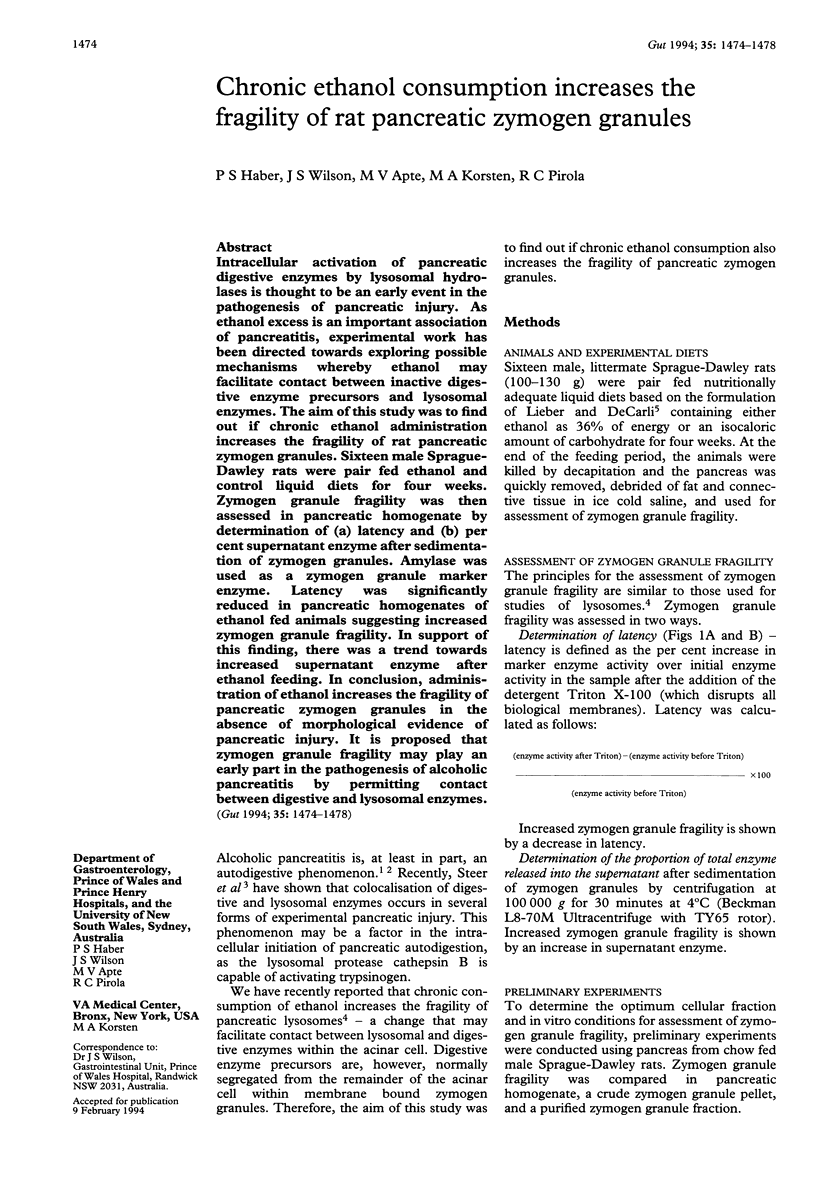
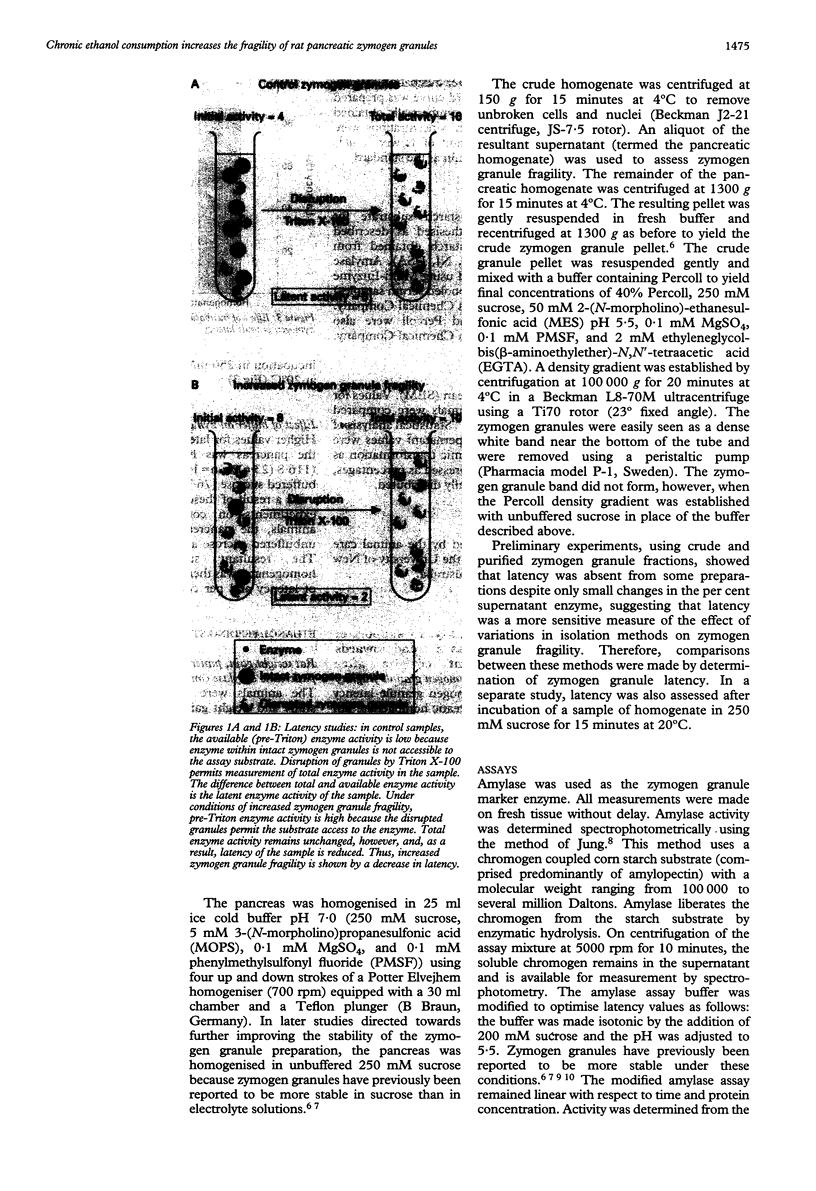
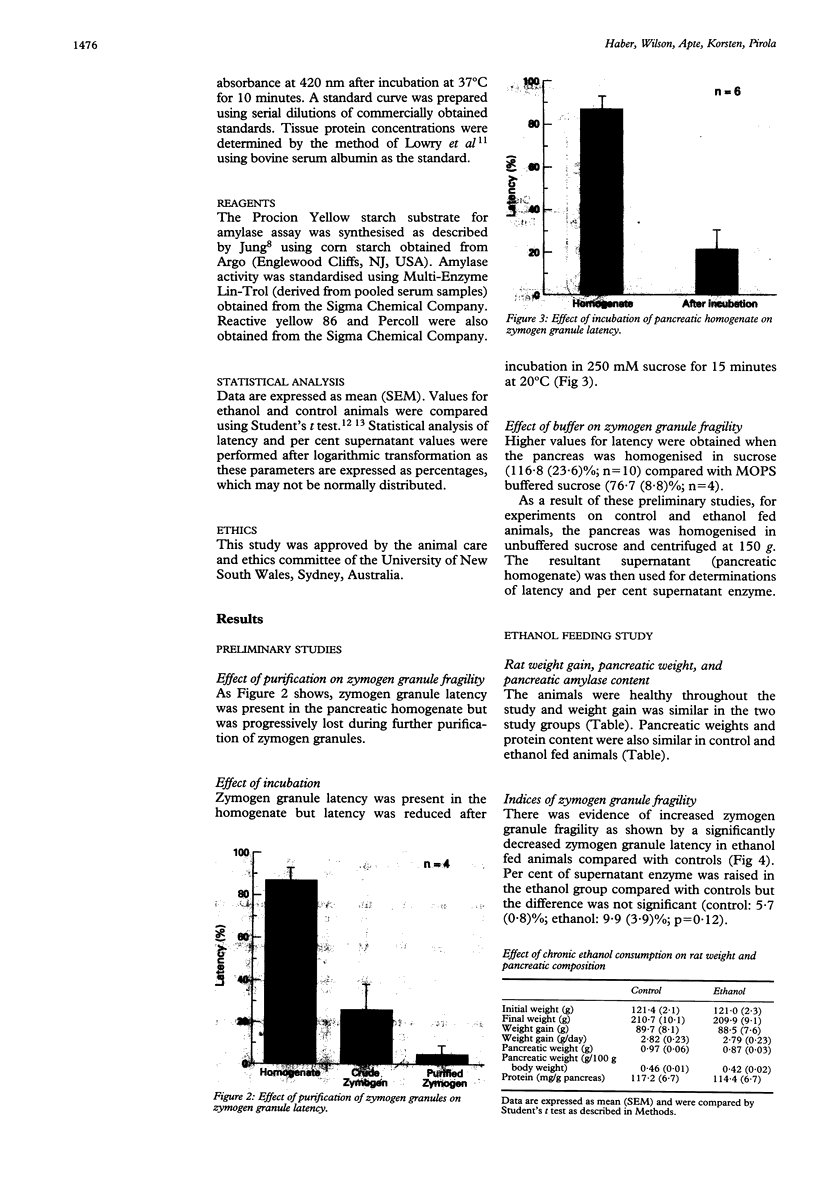
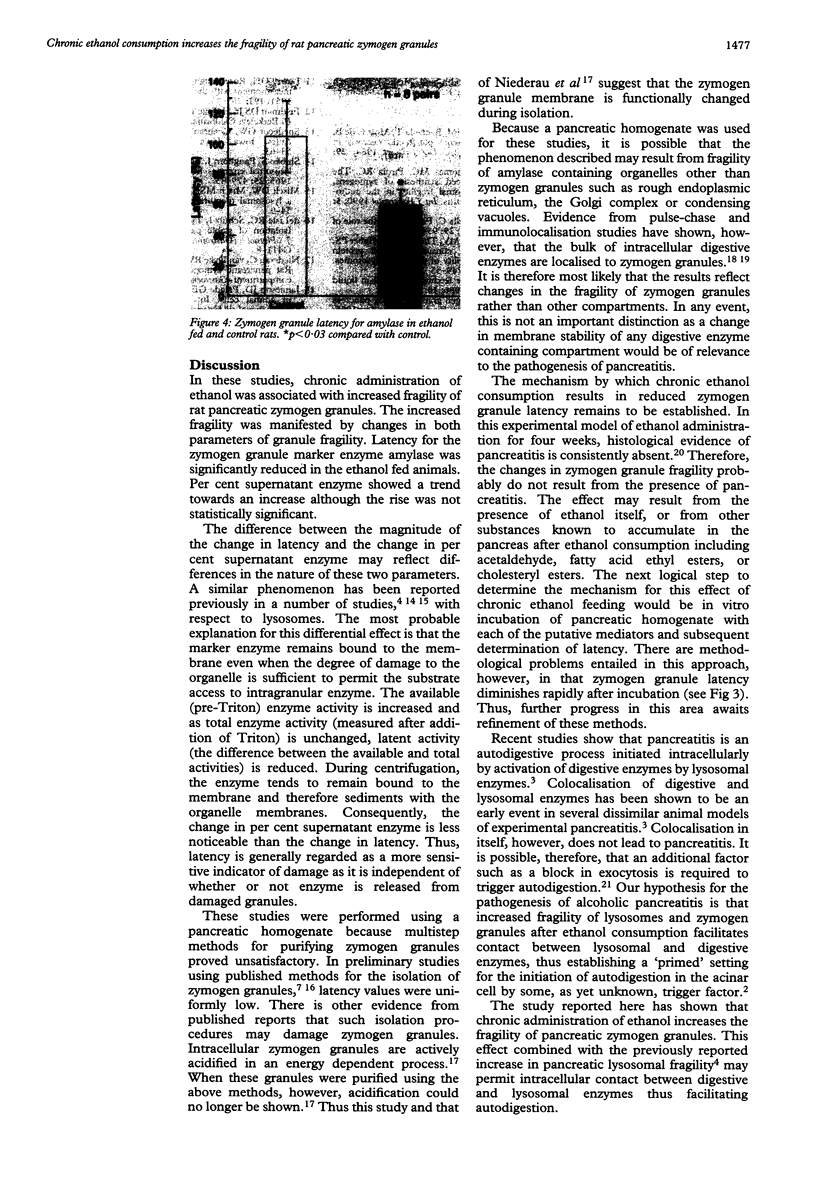
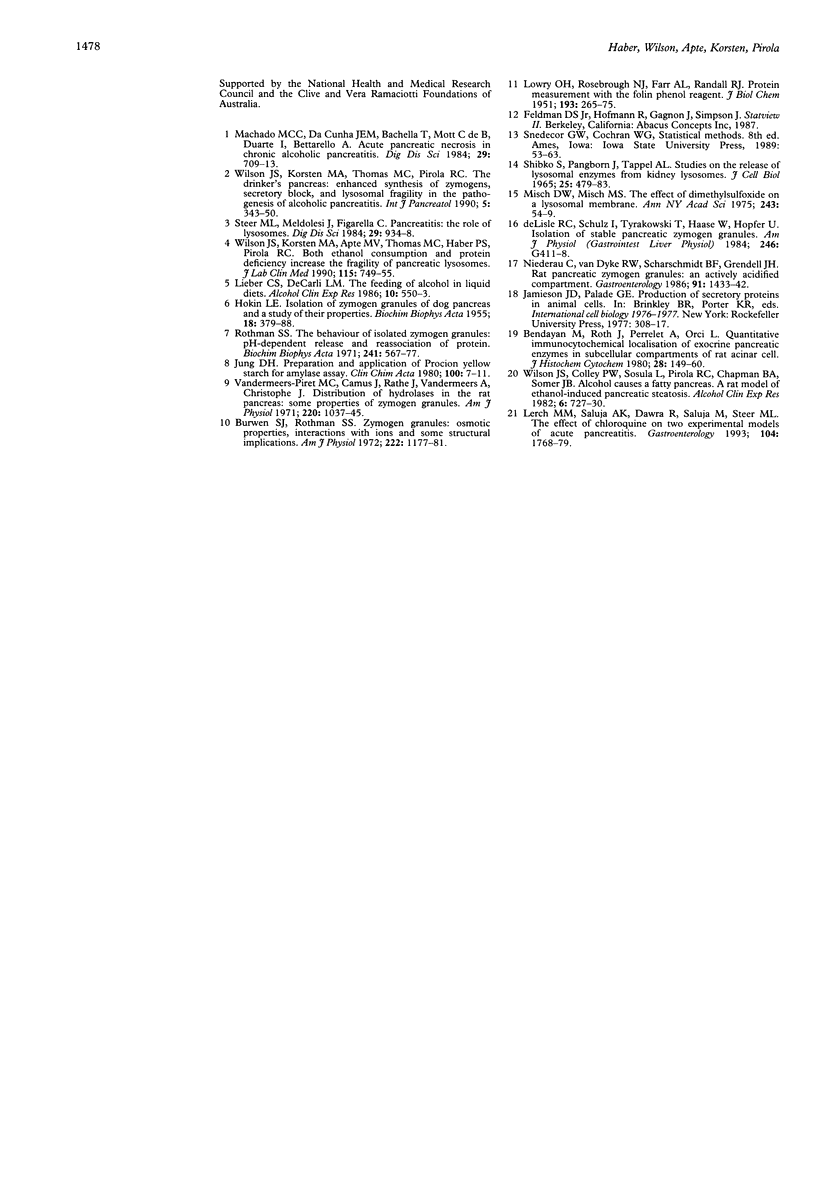
Selected References
These references are in PubMed. This may not be the complete list of references from this article.
- ABELY P., LAB P. De quelques enseignements séméiologiques et doctrinaux découlant de l'usage des neuroleptiques. Ann Med Psychol (Paris) 1957 Nov;115(4):749–754. [PubMed] [Google Scholar]
- Bendayan M., Roth J., Perrelet A., Orci L. Quantitative immunocytochemical localization of pancreatic secretory proteins in subcellular compartments of the rat acinar cell. J Histochem Cytochem. 1980 Feb;28(2):149–160. doi: 10.1177/28.2.7354212. [DOI] [PubMed] [Google Scholar]
- Burwen S. J., Rothman S. S. Zymogen granules: osmotic properties, interactions with ions, and some structural implications. Am J Physiol. 1972 May;222(5):1177–1181. doi: 10.1152/ajplegacy.1972.222.5.1177. [DOI] [PubMed] [Google Scholar]
- De Lisle R. C., Schulz I., Tyrakowski T., Haase W., Hopfer U. Isolation of stable pancreatic zymogen granules. Am J Physiol. 1984 Apr;246(4 Pt 1):G411–G418. doi: 10.1152/ajpgi.1984.246.4.G411. [DOI] [PubMed] [Google Scholar]
- HOKIN L. E. Isolation of the zymogen granules of dog pancreas and a study of their properties. Biochim Biophys Acta. 1955 Nov;18(3):379–388. doi: 10.1016/0006-3002(55)90101-3. [DOI] [PubMed] [Google Scholar]
- Jung D. H. Preparation and application of Procion Yellow starch for amylase assay. Clin Chim Acta. 1980 Jan 1;100(1):7–11. doi: 10.1016/0009-8981(80)90179-5. [DOI] [PubMed] [Google Scholar]
- LOWRY O. H., ROSEBROUGH N. J., FARR A. L., RANDALL R. J. Protein measurement with the Folin phenol reagent. J Biol Chem. 1951 Nov;193(1):265–275. [PubMed] [Google Scholar]
- Lerch M. M., Saluja A. K., Dawra R., Saluja M., Steer M. L. The effect of chloroquine administration on two experimental models of acute pancreatitis. Gastroenterology. 1993 Jun;104(6):1768–1779. doi: 10.1016/0016-5085(93)90658-y. [DOI] [PubMed] [Google Scholar]
- Lieber C. S., DeCarli L. M. The feeding of ethanol in liquid diets. Alcohol Clin Exp Res. 1986 Oct;10(5):550–553. doi: 10.1111/j.1530-0277.1986.tb05140.x. [DOI] [PubMed] [Google Scholar]
- Machado M. C., Monteiro da Cunha J. E., Bacchella T., de Barros Mott C., Duarte I., Bettarello A. Acute pancreatic necrosis in chronic alcoholic pancreatitis. Dig Dis Sci. 1984 Aug;29(8):709–713. doi: 10.1007/BF01312942. [DOI] [PubMed] [Google Scholar]
- Misch D. W., Misch M. S. The effect of dimethyl sulfoxide on a lysosomal membrane. Ann N Y Acad Sci. 1975 Jan 27;243:54–59. doi: 10.1111/j.1749-6632.1975.tb25343.x. [DOI] [PubMed] [Google Scholar]
- Niederau C., Van Dyke R. W., Scharschmidt B. F., Grendell J. H. Rat pancreatic zymogen granules. An actively acidified compartment. Gastroenterology. 1986 Dec;91(6):1433–1442. doi: 10.1016/0016-5085(86)90197-6. [DOI] [PubMed] [Google Scholar]
- Rothman S. S. The behavior of isolated zymogen granules: pH-dependent release and reassociation of protein. Biochim Biophys Acta. 1971 Aug 13;241(2):567–577. doi: 10.1016/0005-2736(71)90055-1. [DOI] [PubMed] [Google Scholar]
- Shibko S., Pangborn J., Tappel A. L. Studies on the release of lysosomal enzymes from kidney lysosomes. J Cell Biol. 1965 Jun;25(3):479–483. doi: 10.1083/jcb.25.3.479. [DOI] [PMC free article] [PubMed] [Google Scholar]
- Steer M. L., Meldolesi J., Figarella C. Pancreatitis. The role of lysosomes. Dig Dis Sci. 1984 Oct;29(10):934–938. doi: 10.1007/BF01312483. [DOI] [PubMed] [Google Scholar]
- Vandermeers-Piret M. C., Camus J., Rathé J., Vandermeers A., Christophe J. Distribution of hydrolases in the rat pancreas: some properties of the zymogen granules. Am J Physiol. 1971 Apr;220(4):1037–1045. doi: 10.1152/ajplegacy.1971.220.4.1037. [DOI] [PubMed] [Google Scholar]
- Wilson J. S., Korsten M. A., Apte M. V., Thomas M. C., Haber P. S., Pirola R. C. Both ethanol consumption and protein deficiency increase the fragility of pancreatic lysosomes. J Lab Clin Med. 1990 Jun;115(6):749–755. [PubMed] [Google Scholar]


